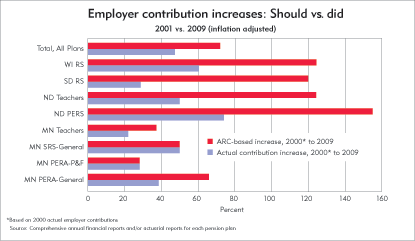As pension officials and lawmaking bodies scramble to stabilize underfunded pension plans, government sponsors and workers are laboring under the weight of steadily growing costs, which are likely to continue upward, maybe substantially.
Since 2000, many employers have seen their contributions rise by anywhere from 20 percent to 70 percent above the rate of inflation (see blue lines in chart). Yet despite these large increases, employers are still not paying what they should on an actuarial basis (via so-called actuarially required contributions, or ARC), which includes normal costs often set in state statute and additional payments to cover unfunded liabilities.
With funded ratios plummeting, ARC amounts—what employers should be paying—have skyrocketed (see red bars in chart). Minnesota’s four largest plans had contributions of $778 million in 2009; based on ARC, contributions should have been more than $1 billion.
Current employees have also shared in that cost pain. Member contributions to Minnesota’s four largest plans have risen by 26 percent since 2000, only slightly slower than the 33 percent increase for employers.
The load of higher pension costs could hardly come at a worse time, as state and local governments struggle with lower tax revenue. For fiscal year 2012, state and local governments face an expected budget shortfall of at least $82 billion. But they will have $38 billion less in stimulus funds to help them deal with deficits, according to a December report from the National Conference of State Legislatures.
States in turn are passing some of the deficit down the ladder in the form of lower local aid, which cuts into locals’ ability to fund pension obligations. In Minnesota, final 2010 aid to cities was $55 million lower than a year earlier, reaching levels last seen in 2001; county aid this year was also cut by 15 percent (about $35 million) over last year. In Wisconsin, aid to local governments dropped by $25 million in 2010 and has been pancake flat since at least 2004.
And for a little final salt in the budget wounds, many state legislatures have recently increased contribution rates yet again for participating employers, or will consider doing so in upcoming legislative sessions.
Ron Wirtz is a Minneapolis Fed regional outreach director. Ron tracks current business conditions, with a focus on employment and wages, construction, real estate, consumer spending, and tourism. In this role, he networks with businesses in the Bank’s six-state region and gives frequent speeches on economic conditions. Follow him on Twitter @RonWirtz.






